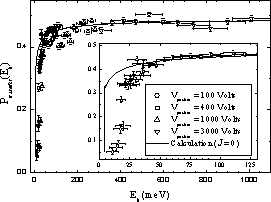VERY SLOW H+ + D(1s) HALF COLLISIONS
E. Wells*, B.D. Esry, K.D. Carnes, and I. Ben-Itzhak
J. R. Macdonald Laboratory, Department of Physics, Kansas State
University, Manhattan, KS 66506 USA
*Current Address: Department of Physics, University of Virginia, Charlottesville, VA
22904-4714 USA
Sub-eV collisions between protons and deuterium atoms have
long been a proving ground for theorists for two primary reasons:
first, the simplicity of the system makes it
ideally suited for studying electron translation factors; and second, HD+
structure calculations are challenging since there is no symmetry under
exchange of nuclei, and as a result, the calculations must extend beyond the
Born-Oppenheimer approximation. Despite
the theoretical interest, there have been very few experiments below 10 eV, due
to difficulties in controlling the collision energy.
A new experimental approach allows the measurement of H+
+ D(1s) collisions down to a few meV, lower by more than an order of
magnitude and with better energy resolution than previous measurements.
This new experimental approach uses the ground state
dissociation (GSD) of HD+ to produce H+ + D(1s) "half"
collisions1,2. Fast proton
impact with neutral HD initiates vertical transitions that populate the
vibrational continuum of the
HD+(1sσ)
state about 1% of the time, resulting in a very slow
dissociation. The half collision energy is determined a posteriori from
the measured momentum vector of each charged fragment using a COLTRIMS-style
apparatus3.
For the half
collision system, the coupled channels problem is solved using a variational R-matrix
approach with incoming-wave boundary conditions.
The Franck-Condon transition from the neutral molecule is taken
into account by projecting the outgoing waves onto the ground state of the HD
molecule. The coupled channels
calculations are solved in a similar manner for the "full" collision system4.
The experimental results, shown in Figures 1 and 2, provide a direct test of
the half collision calculations. The
experimental and theoretical results are in good agreement, except in the
region very near the charge transfer threshold, where systematic problems with
the subtraction of contaminant H2+ molecular ions plague
the experiment. Since similar
computational techniques are used for both the full and half collision systems,
these experimental results can also probe calculations of full collisions at
much lower energies than previously accessible.
Improvements in the experiment should allow measurements of the
threshold behavior in charge transfer and resonances in the elastic channel.
Figures:

Figure 1:
Experimental and theoretical results for
charge transfer in the H+ + D(1s) half collision system.
Vpusher is a measure of the strength of the extraction field.

Figure 2:
Experimental and theoretical results for elastic
scattering in the H+ + D(1s) half collision system. The
structure in the calculations below
Ek = 3.7 meV
is due to two J = 0 Feshbach resonances2,4.
References:
1) I. Ben-Itzhak et al., Phys. Rev. Lett. 85, 58 (2000).
2) E. Wells et al., Phys. Rev. A 62, 062707 (2000).
3) E. Wells et al., submitted to Phys. Rev. Lett. (2001).
4) B.D. Esry et al., J. Phys. B 33, 5329 (2000).
This work was supported by the
Chemical Sciences, Geosciences and Biosciences Division,
Office of Basic Energy Sciences,
Office of Science,
U.S. Department of Energy.
Submitted to ICPEAC 2001, July 2001 in Santa Fe, NM.
This abstract is also available in
Postscript or
Adobe Acrobat formats.

